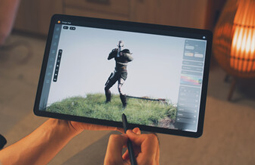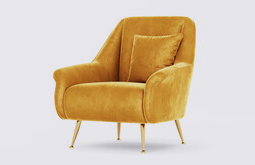Understanding 3D Digital Sculpting: A Complete Guide
Often, we see the line between the real world and digital world getting blurred. This is a case in 3D digital sculpting, where digital sculptors, much like conventional real-world sculptors, use tools to manipulate digital geometry, or digital clay. In the rapidly evolving digital realm, 3D modeling is integral for various industries across the globe. One of the cornerstones of digital modeling is the much more advanced digital 3D modeling that brings 3D artists’ creative imaginations to reality.

So, welcome aboard to our detailed guide on this advanced modeling method. This article is going to explore the concept of digital sculpting, its techniques, pros and cons, and software applications used. Stick with us until the end and unleash the limitless possibilities of hyper-realistic model creation through 3D sculpting in 2024 and beyond! Let’s begin.
What is digital sculpting, and what significance does it have in 3D modeling?
Digital sculpting is an advanced method of creating hyper-realistic and detailed 3D models through sculpting or physically manipulating the model mesh, or “digital clay”. The entire process happens through high-end intuitive tools and brushes within a CG environment. Professional 3D sculpting artists simulate real-world sculpting techniques, such as pinching, pulling, pushing, smoothing, twisting, carving, inflating, etc., to create intricate detailing on the model.
By applying accurate precision and control, the artists can refine and shape their creations, allowing seamless texture and surface integration. There are intuitive sculpting brushes, which are the primary tools that simulate real-world techniques as mentioned above that are required to shape the mesh structure or the virtual clay.
Being one of the most revolutionary digital modeling procedures, 3D sculpting has several implications. Some of them are:
-
Creative freedom
Digital sculpting gives remarkable creative freedom and flexibility to 3D sculptors, allowing them to unleash their creativity beyond traditional tools. Since there is no usage of any physical material and everything is digital, the modelers can effortlessly experiment with any forms, shapes, or styles, unlocking artistic expression. Models of aliens, futuristic buildings, weapons, automobiles, and mythological and fictional creatures – are all the most common types of digital 3D sculpting models.
-
High level of control
The tools used in the process offer significance, control, and absolute precision to the modelers. From the minute details to the overall model composition, they can exert their control over every aspect of the procedure. This enables the artists to achieve lifelike realism with perfect detailing.
-
Offers adaptability and versatility
3D sculpting tools and software programs are perfectly suitable for a diverse range of platforms throughout numerous domains. From architectural modeling and furniture 3D design to digital graphics creation and product modeling, this process can be digitally applied to any of these, and more. These digital sculpting and 3D modeling examples are immensely integral to modern lives. This makes digital sculpting an indispensable tool for various 3D designers and CGI artists.
-
Seamless integration with other software programs
3D sculpting tools can seamlessly integrate with other 3D design and rendering software. This fosters productive collaboration between team members, ensuring compatibility with existing workflows. Artists can effortlessly import and export the models between different software and platforms, thus achieving a vast range of surface textures and effects.
-
Offers quick design iteration
The best trait of 3D sculpting is that the process allows quick and efficient design iteration, unlike traditional sculpting. In the latter, if any aspect or feature of the model seems wrong, the entire model needs to be redone from scratch. On the contrary, in digital sculpting, whether a small chance or a major one, the artists can make the changes easily and refine the model with a few clicks and brush strokes. This iterative approach makes 3D sculpting the most preferred modeling method.
Commonly used techniques for 3D digital sculpting
Emerging as one of the most powerful 3D design processes, digital sculpting comes with a wide variety of advanced techniques and procedures. 3D artists must be thorough with all these techniques to achieve visually stunning and hyper-realistic results. Knowing them, they can also select the best one to use as per project requirements, as well as the resources they have at hand.
-
Layers and masking
This technique helps sculpting professionals refine models in a non-destructive manner. That means, they can experiment and iterate the models until perfection and the desired result is achieved, without altering any underlying mesh structure. The artists can also add multiple layers to distinguish the different parts of the model and apply masks to manipulate specific areas without impacting the geometry.
-
Retopology
With this technique, professional 3D sculptors create a perfectly optimized and clean mesh topology. This is mostly required for animation, rigging, and rendering purposes. Once the high-resolution models are created, the artists implement the retopology tools and develop a lower resolution mesh having a proper topology and clean edge loops.
-
Blocking out
This technique facilitates the primitive shapes and proportions needed to create the model. These basic shapes include cubes, spheres, cylinders, boxes, triangles, etc. The artist uses these shapes to get a rough approximation of the final form and the overall proportions and silhouettes.
-
Subdivision surfaces
This technique allows the creation of smooth, real-world organic shapes by the process of subdividing the mesh into much smaller polygons. The higher the subdivision level, the higher the level of detail and smoothness achieved. This technique is ideal for sculpting ultra-realistic detailed models with intricate surfaces.
-
UV mapping
This technique unwraps the surface of the digital model onto a 2D flat texture or plane. This allows for the textures and materials to be applied to the model to give it a real look. The artists must ensure a proper UV mapping process, to ensure the textures are applied evenly across the model’s surface. Else, chances of stretching and distortion can arise.
-
Detailing and texturing
Using intuitive brushes, texture maps, and alphas, digital sculptors add maximum surface details and realistic looking textures to the sculpted model. Natural blemishes and imperfections, such as wrinkles, pores, scratches, dents, scales, etc., are added through this technique, elevating the model’s realism and visual appeal.
These are some of the techniques leveraged by professional sculptors to facilitate a dynamic modeling process. Given the technical nuances and artistic eye required to pull off the above techniques, it is best to hire professional 3D design service providers for the job
Our next segment is about the pros and cons of digital sculpting in 3D modeling in detail. Let’s check them out.
Advantages and disadvantages of 3D digital sculpting models
In many ways, digital sculpting has revolutionized the way 3D model creation is done. By applying highly intuitive sculpting brushes and tools, 3D specialists can create highly realistic models for numerous practical applications across several business domains. However, as is natural in any creative process, this 3D design process also has its fair share of disadvantages or cons.
In this section, we will discuss the advantages and disadvantages of 3D sculpting alike. Read this section until the end, and you will get valuable insights on this 3D design approach.
Advantages:
-
Flexibility to explore creativity
- Gives the sculpting artists exceptional creative flexibility.
- They can experiment with organic and inorganic models, shapes, and forms.
- They can enjoy freedom to create models with high precision and control.
-
Efficient workflow
- Not time-consuming and resource-intensive like traditional sculpting.
- Streamlines model creation process with efficient and rapid iteration.
- Artists can experiment with different ideas and refine the models with ease.
-
Offers hyper-realistic detailing
- Artists can create hyper-realistic detailed models for various purposes.
- They can create real-world blemishes and imperfections applying 100% natural-looking textures on the model surfaces.
- With techniques like pull, twist, carve, indent, smooth, etc., the models look more real than other 3D modeling techniques.
-
Highly adaptable and compatible
- Highly compatible with other 3D modeling and rendering software programs and platforms.
- Can be used to create detailed 3D models for a vast range of applications.
- Facilitates a collaborative work environment.
Disadvantages:
-
Steep learning curving
- Difficult for beginners or amateurs to master the process.
- Too many intricacies are involved pertaining to the usage of intuitive brushes and tools.
- The 3D sculpting software are also too technical, requiring in-depth 3D modeling knowledge.
-
High dependency on technology
- The process relies heavily on technology, escalating risks like data loss, compatibility issues, etc.
- High dependency on technology also leads to system crashes, software bugs, and unexpected errors.
- These disrupt the workflow and elevate regular software maintenance and backups.
-
Aesthetic limitations
- Although digitally sculpted models are highly artistic, the process has limitations in fully replicating physical materials.
- Often, the models fail to replicate 100% natural-looking traits.
- This leads to loss of authenticity and discrepancies in the artwork.
-
High-end system requirements
- Highly resource and labor-intensive, requires powerful hardware.
- High-performance system requirements with ample memory, processing power, and graphics cards.
- Difficult for beginners or amateur 3D artists and SMEs to invest.
-
Certain topology shortcomings
- Challenging to maintain optimized and clean topology in detailed models.
- Mesh distortion, artefacts, and stretching, can arise, especially while subdivisioning the surfaces or sculpting finer details.
- Requires absolute attention, sharp eye for detail, and immediate rectification.
There you are. A detailed checklist of the advantages and challenges of the sculpting process. By carefully analyzing these pros and cons, 3D artists can master the nuances of the process, achieving high-detail models and 3D artwork. Our following segment will list the leading software programs used for digital 3D sculpting. Hope this will help all 3D design professionals harness the full potential of digital 3D modeling.
Software applications used for digital sculpting process
- ZBrush
- Mudbox
- Cinema 4D
- Modo
- 3D Coat
- Blender
- Sculptris
- Meshmixe
- Sculptgl
- Rocket F
- SelfCAD
- ZBrushCoreMini and ZBrushCore
- 3DC Printing
- Autodesk Maya
To learn more details about each of the software programs, read the in-depth blog post below.
Useful Link: 14 Best 3D sculpting software
Conclusion
To conclude, 3D digital sculpting offers unparalleled creative freedom to modern 3D artists. From experimenting with different forms and shapes to creating highly detailed, natural-looking 3D models, a lot can be created with this modeling process. Hope this comprehensive blog article will inspire and amplify the journey of any digital designer.
Considering the technicalities involved in the process and the high level of expertise the workflow demands, only experienced 3D specialists are ideal for digital sculpting services. Several professional 3D service providers are there who can offer the best possible 3D sculpted models at reasonable pricing.
So collaborate with such a seasoned team and unlock a dynamic landscape of futuristic digital art and 3D design.




